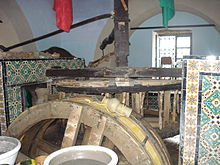Bir Barrouta
Bir Barrouta, one of the oldest wells in Kairouan, is crowned with a legend: it would be, according to an old popular belief, connected (because communicating in depth) to the sacred well of Mecca Bir Zemzem3,4. Dug in the year 180 of the Hegira (corresponding to the year 796) by the Abbasid governor of Ifriqiya Harthama Ibn El Ayoun, the well is housed in a building whose current state dates from the reconstruction ordered by the sovereign Mouradite Mohamed Bey El Mouradi in 1690.
The monument, measuring thirteen meters in height, 18.5 meters in length and 13.5 meters in width, is located on the main artery of the Kairouan medina. From the outside, the building opens onto the street through two niches housing a drinking trough above which are placed marble taps. The facade presents a commemorative plaque in white marble bearing a poem in Naskhi characters which celebrates the construction of the building and dates from 16905. The interior consists of a room, accessible by a staircase, of almost square plan and of which the walls are carved with horseshoe arches resting on piers. It is surmounted by a dome on corner trunks which is linked to the model of the Kairouan domes; a chiseled stucco panel reveals the name of the master mason, Muhammad al-Zaqraoui.
In the room, a noria operated by a camel ensures the water supply to the well. This machine is made up of two superimposed wooden wheels; cruciform beams retain the iron axis fixed to two walls located on either side. The buckets, riveted on sticks that connect the two wheels, collect the water at the bottom of the well5. On the ground floor, an ingenious system allows the recovery and reuse of water lost by the buckets.
Bir Barrouta is one of the many hydraulic works which ensure the supply of water to the Kairouans. To cope with the lack of water resulting from the semi-arid climate of Kairouan and complement the many basins and cisterns collecting rainwater, the city has also, throughout its history, equipped itself with hydraulic installations (including Bir Barrouta is an example) which allow the exploitation of the water table

